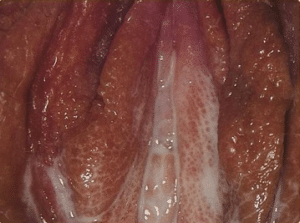Gonorrhoea is a curable sexually transmitted infection caused by the Gram-negative bacterium Neisseria gonorrhoeae. In the UK, gonorrhoea is the second most common bacterial STI (after chlamydia) and predominantly affects people under the age of 25 and men who have sex with men.
Throughout this article we will discuss the pathophysiology of gonorrhoea, its clinical features, management and how it may affect pregnancy and the neonate.
Pathophysiology
Gonorrhoea is transmitted through unprotected vaginal/oral/anal sex and can also be vertically transmitted from mother to child.
Neisseria gonorrhoeae is a Gram-negative diplococcus that has a strong affinity for mucous membranes. The organism can infect the uterus, urethra, cervix, fallopian tubes, ovaries, testicles, rectum, throat and less commonly the eyes. Once adhered to the mucous membrane, it invades the host cell and causes acute inflammation. N. gonorrhoea also has surface proteins that bind to the receptors of immune cells thus preventing an immune response.
Risk Factors
The following are risk factors associated with gonorrhoea, most of which are common to other STIs:
- Aged <25 years
- Men who have sex with men
- Living in high density urban areas
- Previous gonorrhoea infection
- Multiple sexual partners
Clinical Features
While gonorrhoea is often asymptomatic, as occurs in around 50% of female cases, symptoms can usually develop 2-5 days following infection:
Genital infection
Female

Figure 1. Vaginal discharge in female gonorrhoea infection
Symptoms:
- Altered/increased vaginal discharge (commonly thin, watery, green or yellow)
- Dysuria
- Dyspareunia
- Lower abdominal pain
- Rarely – intermenstrual and/or post-coital bleeding
Signs:
- Mucopurulent endocervical discharge
- Easily induced cervical bleeding
- Pelvic tenderness
Often examination can be normal.
Male
Symptoms:
- Mucopurulent/purulent urethral discharge
- Dysuria
Signs:
- Mucopurulent/purulent urethral discharge
- Epididymal tenderness
Rectal infection
- Usually asymptomatic
- Anal discharge
- Anal pain/discomfort
Pharyngeal infection
- Usually asymptomatic (>90%)
Differential Diagnoses
A full STI screen should be undertaken for a patient presenting with gonorrhoea due to the common presenting symptoms of various STIs.
In particular, it is often very difficult to clinically differentiate between gonorrhoea and chlamydia infection. These infections often co-exist and therefore empirical treatment for gonorrhoea has the aim of covering both the causative organisms.
Investigations
If someone has suspected gonorrhoea, they should be referred to a GUM clinic or other specialist sexual health service for specimens to be taken:
- Females:
- Endocervical/vaginal swab – NAAT
- Endocervical/urethral swab – microscopy and culture
- Males:
- First pass urine – NAAT
- Urethral/meatal swab – microscopy and culture
- Swabs for NAAT + microscopy & culture can be obtained from the throat, rectum or eye if indicated.
These swabs should then be sent for microscopy, culture or nucleic acid amplification testing (NAAT). NAATs are the standard investigation for chlamydia and these tests often provide dual testing for both chlamydia and gonorrhea.
While waiting for these laboratory results the patient should be treated with empirical antibiotics if their signs and symptoms are indicative of gonorrhoea.
Management
Following diagnosis of gonorrhoea, a patient should be treated with a single dose of intramuscular ceftriaxone 1g.
Patients should be offered screening for other STIs, especially chlamydia, as co-infections are common. People should be encouraged to contact previous sexual partners to advise them to be screened and treated empirically for gonorrhoea.
Future safe sex should also be encouraged and patients should abstain from sex until both partners have completed treatment. To ensure antibiotics have successfully treated a patient, a test of cure is recommended during a follow up appointment.
For full details please refer to the BASHH UK guidelines for the management of gonorrhoea.
Complications
If gonorrhoea is left untreated in females, it can lead to pelvic inflammatory disease (PID), which can result in chronic pain, infertility and ectopic pregnancy. In males, gonorrhoea can spread from the urethra to the testes causing epididymo-orchitis which is painful but rarely leads to infertility. It can also lead to prostatitis. Disseminated gonococcal infection (DGI) is uncommon but can lead to joint pain and skin lesions.
A patient should be admitted to hospital if:
- Systemic symptoms are identified (e.g. malaise, joint pain, fever, rash) as this suggests disseminated gonorrhoea which can potentially develop into a life threatening infection such as gonococcal meningitis.
- Females show signs of complicated or severe pelvic inflammatory disease.
Gonorrhoea in Pregnancy
Having gonorrhoea during pregnancy may be associated with complications such as perinatal mortality, spontaneous abortion, premature labour and early fetal membrane rupture.

Figure 2. Neonatal conjunctivitis may develop if born to an untreated woman with gonorrhoea.
Gonorrhoea can be vertically transmitted during delivery from an untreated mother and this can cause the neonate to have gonococcal conjunctivitis, where the neonate will experience eye pain, redness and discharge. Prophylactic antibiotics can prevent this and treatment during pregnancy is the same as for uncomplicated gonorrhoea. For the infected neonate, urgent referal and appropriate treatment is necessary to prevent long term damage and blindness.
